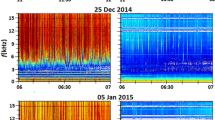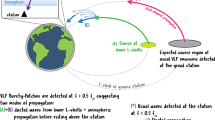Abstract
VLF emissions the signal strength of which changes with time with a period longer than the two hop whistler group delay are called long period VLF emission pulsations1 or quasi-periodic (QP) VLF emissions2. About 400 QP events were observed in the VLF emission data recorded on chart at Byrd Station in Antarctica during 6 months (February–April, September–November 1964). VLF emissions were recorded in the frequency range 1–2.4 kHz and in a narrow band centred on 8 kHz. Additional observations were occasionally made at 400 Hz. QPs have been observed on the two lower frequency channels, though not necessarily simultaneously. They have never appeared on the 8 kHz channel. QPs were observed mostly when Byrd Station was on the daylight side of the Earth. Periods of QPs range from 10 s (the lowest limit resolvable) to about 2 min and occasionally up to 10 min. A QP event usually lasts for several tens of minutes. Sometimes it lasts for only a few minutes and sometimes for a few hours.
Similar content being viewed by others
References
Carson, W. B., Koch, J. A., Pope, J. H., and Gallet, R. M., J. Geophys. Res., 70, 6293 (1965).
Helliwell, R. A., Whistlers and Related Ionospheric Phenomena (Stanford University Press, 1965).
Author information
Authors and Affiliations
Rights and permissions
About this article
Cite this article
KITAMURA, T., JACOBS, J., WATANABE, T. et al. Investigation of Quasi-periodic VLF Emissions and their relation to Geomagnetic Micropulsations. Nature 220, 360–361 (1968). https://doi.org/10.1038/220360a0
Received:
Revised:
Published:
Issue Date:
DOI: https://doi.org/10.1038/220360a0
- Springer Nature Limited
This article is cited by
-
Characteristics and longitudinal extent of VLF quasi-periodic emissions using multi-point ground-based observations
Earth, Planets and Space (2023)
-
Thunderstorms, Lightning, Sprites and Magnetospheric Whistler-Mode Radio Waves
Surveys in Geophysics (2008)





